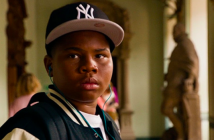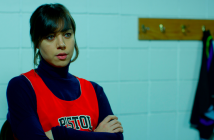Editor’s Note: The following interview is part of our coverage of the 2015 Cannes Film Festival. For more information please visit www.festival-cannes.com/en or follow the Cannes Film Festival on Twitter.
Green Room, written and directed by Jeremy Saulnier, is a revenge thriller set at a rock venue where a hardcore punk band is trapped in a Green Room facing off neo-Nazis after witnessing a murder at the club. With its one-location setting and the constant Nazi threat, Saulnier’s follow-up to Blue Ruin is intense, bloody and also quite dark-humored. It’s a powerful, suspenseful genre film which received critical acclaim after its premiere within the Director’s Fortnight sidebar of the Cannes Film Festival.
Where did this idea for the Nazis vs. Punks theme of Green Room come from? Are you a big punk fan yourself?
Jeremy Saulnier: I certainly was part of the vibrant punk scene in Washington D.C. It was the age of hardcore, in the middle of the evolution of punk and there was a presence of Nazi skinheads in the early 90s, so that was my world. At every show there was violent, massive dancing and fights broke out. Sometimes people attacked Nazis, sometimes Nazis attacked people but it was just very scary at times. But we were all there to have this release and be part of the energy. As I grew up I went from one scene to the next. I was into B-Boy for a while and I went from Virginia to New York. It was kind of the same thing: it was people in not in a pit but in a circle and you were not slamdancing but you were breakdancing. That was my attraction. There is also something about this static of punk and hardcore, that energy and that raw sound that always stuck with me. I knew, as soon as I had a chance to make that kind of a movie I would and Blue Ruin opened the door for me. First thing I did was not look ahead and try to make a bigger studio film but look back and bring in all of my friends from the 1990s and make this crazy movie.
You have done this classic, one-location film with great intensity. Did you find that tension while you were going for this story?
JS: I have been in these punk rock venues and they look amazing, they are scary as hell sometimes but they are real. I don’t need any supernatural elements, I can just have like a Straw Dogs scenario but in this world. And you get super scared. The army boots and the Mohawks –it’s really, visually, like a Mad Max film. I love tension and I saw in Blue Ruin that the audience’s response was really amazing in terms of the tension we created. I wanted to ratchet that up like 10 times and see if I can do that primarily when there is no violence. A lot of this movie is zero violence at all and I tried to create tension there. The violence is more a release, but it is the threat that really gets people at the edge of their seats.
Green Room features very brutal pitbull attacks but in one of the final scenes, the dog is shown in a sort of redeeming, very loyal scene. Where did this pitbull image come from? Are you a dog lover?
JS: I am a huge dog lover, but a couple of years ago my daughter was attacked by a dog and it was traumatic. I haven’t really recovered from that, my daughter has fortunately. The image of the dog was a way to brace it and flush out all my fears and my terror and realize at the core of hopefully every dog and every human there is a decent thing. The dogs were always meant to represent the power of learned aggression and learned hatred and how the humans have, in this case with the pitbulls, literally breed them to kill. The pitbull did not design its genetic makeup, the humans did.
I definitely wanted a female character to overtake the movie and move it in a position of a traditional male action hero.
Were you influenced by certain filmmakers in terms of contrasting violence with dark humor?
JS: I always refer to the Coen brothers. The way they infuse comedy into their stories. They use very graphic violence and a second later you’re laughing. I always hope to achieve my own space, my own signature style but I think I would say the Coens are the best for me.
Your cast consists of many British actors. How come?
JS: I just go for the people who fit the world. I think a lot of the big agencies in America want to cast the next superhero movie or cast the next big American beefcake. I find that a lot of the people who seem more human to me happen to come from the UK right now. I just cast people who are best for the role and that’s how it worked out.
Why did you choose Patrick Stewart?
JS: (laughs) He chose us, let’s be honest here.
Did you have him in mind while writing his character?
JS: I haven’t even thought that high. I was looking for some American character actor. Patrick Stewart got his hands on Blue Ruin and loved the tension and was looking to shake things up a bit. We share a management company and we were introduced and he saw the script for Green Room and wanted to do it. We submitted a detailed history of his character, so he’d have more to latch onto because he was like “I don’t do exposition; I don’t do detailed expository passages for the audience”. So once he got a hold of the character’s history he could really take it from there and he was great, very generous. I was a little shocked at how easy it was to work with him. He was dedicated and knew all his lines. You know, you hear horror stories about Hollywood actors and how they only care to come for a paycheck. He came to work and I was very grateful.
Imogen Poots’ character is actually the most powerful character in the group. Would you say this film is a female empowerment film?
JS: I definitely wanted a female character to overtake the movie and move it in a position of a traditional male action hero. Imogen’s character Amber is the most pragmatic level-headed. I mean, she is definitely disturbed and has a distorted history but she is the only bad-ass amongst the people trapped in this room.
After Blue Ruin, you said you didn’t want to make a studio film. Are you ready to move a step forward and do a studio film now?
JS: It’s an education. It’s my first time working within the industry, which is not easy for me. I’m used to sort of being my own boss and doing crazy things to get things done and never stop until they are done. It was tough for me to give away certain control as far as the pace I want to work is concerned and it ended up being great. But I’ve learned lots of lessons and I’ve got thicker skin and I feel like I can play nice and be part of the industry now. I needed this film to sort of acclimate me to that environment. As far as the technical level or budget, that does not intimidate me. What intimidates me is giving away control to a committee. They can be very dangerous in terms of creative progress. If I can maintain control or can find partners that are completely in line with what I want to do, I’d gladly take on a studio film.
If I can maintain control or can find partners that are completely in line with what I want to do, I’d gladly take on a studio film.
You come from a different background than most filmmakers since you worked in the technical department. Do you think that gives you advantages?
JS: I always consider myself a director but I do things in a very practical way. When I didn’t attract attention or couldn’t get my scripts off the ground I wanted to keep working in film and so the easiest way to do that is to learn a trait that is technical because you can’t just say you are a cinematographer and be one. You can say you are a director and you have to get it together and make a movie but to be a cinematographer you have to build a body of work and earn your way up. I was always on set learning from directors but for me the whole technical side was an additional education. It definitely paid off but it was a means to coming back to directing. Logistically, I know how to light, put down dolly tracks, know how to logistically plan a scene but more importantly I know my lenses and I know where to put the camera. But that is more directing, you need to know your lenses and you need to know your craft. I always approached a film, even as a director, visually. The camera to me is just inherent to the process and it’s all one collective effort. I don’t really separate departments.
Did the music in the film include bands that you know?
JS: Some of the music is written by my high school friends and punk rock bands, some of it is just bands I admire and some of them are bands that I fear. It’s really good having a whole collection of bands I never thought I would see in one movie.
In Green Room, the characters keep on discussing their desert island band. What’s your desert island band?
JS: My desert island band changes every day but primarily it is Black Sabbath.
What’s next for you?
JS: I don’t really know but I have a feeling that it is not going to be a hardcore genre movie.
Is your next film going to be red or yellow?
JS: I’ve decided: no colors.
What’s your favorite color by the way?
JS: My favorite color would probably be blue. It’s my safe color. I like green too. Oh hey, that solves that.




